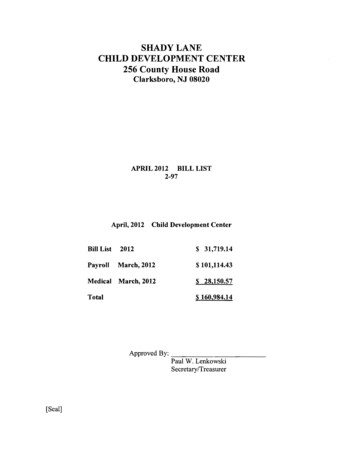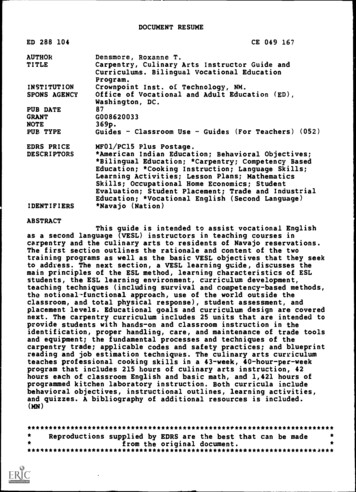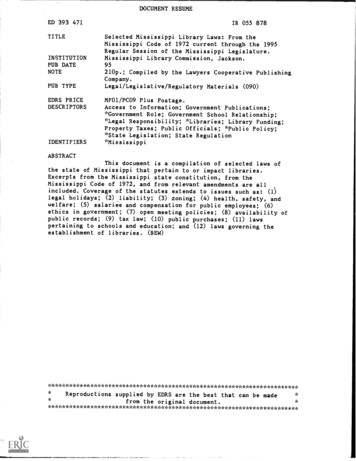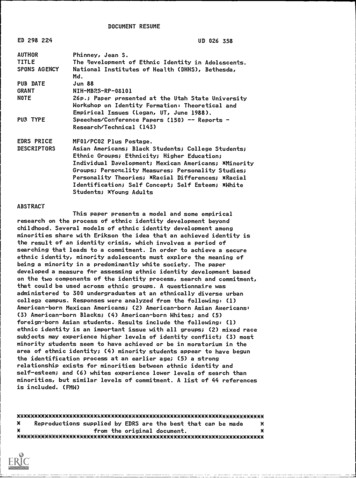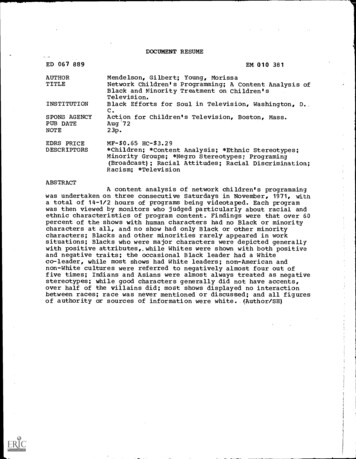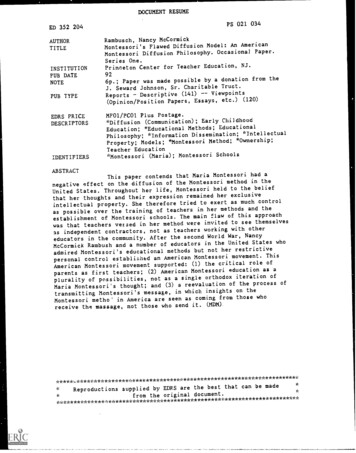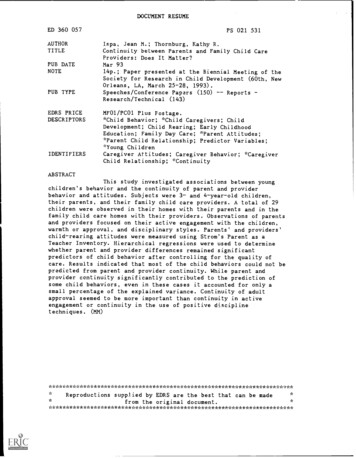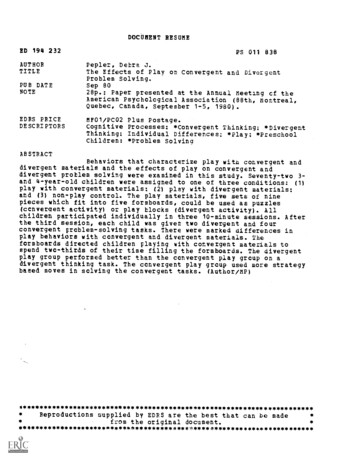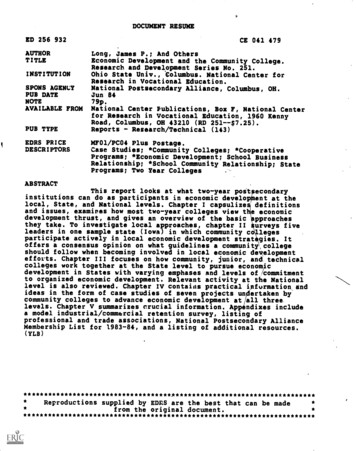
Transcription
DOCUMENT RESUMEED 256 932AUTHORTITLEINSTITUTIONSPONS AGENCYPUB DATENOTEAVAILABLE FROMPUB TYPEEDRS PRICEDESCRIPTORSCE 041 479Long, James P.; And OthersEconomic Development and the Community College.Research and Development Series No. 251.Ohio State Univ., Columbus. National Center forResearch in Vocational Education.National Postsecondary Alliance, Columbus, OH.Jun 8479p.National Center Publications, Box F, National Centerfor Research in Vocational Education, 1960 KennyRoad, Columbus, OH 43210 (RD 251-- 7.25).Reports - Research/Technical (143)MF01/PC04 Plus Postage.Case Studies; *Community Colleges; *CooperativePrograms; *Economic Development; School BusinessRelationship; *School Community Relationship; StatePrograms; Two Year. CollegesABSTRACTThis report looks at what two-year poitsecondaryinstitutions can do as participants in economic developnent at thelocal, State, and National levels. Chapter I capsulize definitionsand issues, examines how most two-year colleges view t e economicdevelopment thrust, and gives an overview of the basic pproachesthey take. To investigate local approaches, chapter II urveys fiveleaders in one sample state (Iowa) in which community co logesparticipate actively in local economic development strat gigs. Itoffers a consensus opinion on what guidelines a community, collegeshould follow when becoming involved in local economic developmentefforts. Chapter III focuses on how community, junior, and technicalcolleges work together at the State level to pursue economicdevelopment in States with varying emphases and levels of /commitmentto organized economic development. Relevant activity at the Nationallevel is also reviewed. Chapter IV contains practicalandideas in the form of case studies of seven projects un ertaken bycommunity colleges to advance economic development at/all three.levels. Chapter V summarizes crucial information. Appendixes includea model industrial /commercial retention survey, listing ofprofessional and trade associations, National Postsecondary AllianceMembership List for 1983-84, and a listing of additional s supplied by EDRS are the best that can be made**from the original ******************************
':;v4.4;2.17.:4,1,1'PI' '.%.'1.1.:; 11.! tt.r, ' 11,.,,' ."'.7. 4-IV 5 1.t,,,,51.:-ij" , .i.-,,7, 1 I.,104P1.fCONQMIC.DEVELOAND THECOMMUNITY COLLEGEU.L. DEPARTMENT OF EDUCATIONNATIONAL INSTITUTE OF EDUCATIONEDUCATIONAL RESOURCES INFORMATIONCENTER (ERIC)"PERMISSION TO REPRODUCE THISMATERIAL HAS BEEN GRANTED BYThis document has been reproduced asreceived from the person or organizationoriginating itMinor changes have been made to improvereproduction qualityPoints of view or opinions fated in th.s document do not necessarily represent official NIEposition or policyTO THE EDUCATIONAL RESOURCESINFORMA !ION CENTER (ERIC)."*CITIIIi\NATP3IIAL CENTERFOR RESEARCH IN VOCATIONAL EMICATION4444." THE OHIO STATE UNIVERSITY1960 KENNY ROAD COLUMBUS. OHIO 43210/2O
1THE NATIONAL CENTER MISSION STATEMENTThe National Center for Research in Vocational Education's mission is to increase the ability ofdiverse agencies, institutions, and organizations to solve educational problems relating toindividual career planning, preparation, and progression. The National Center fulfills its missionbyGenerating knowledge through researchDeveloping educational programs and productsEvaluating individual program needs and outcomesProviding information for national planning and policyaInstalling educational programs and productsOperating information systems and servicesConducting leadership development and training programsFor further information contact:Program Information OfficeNational Center for Research;n Vocational EducationThe Ohio State University1960 Kenny RoadColumbus, Ohio 43210Telephone: (614) 486-3655 or (800) 848-4815Cable: CTVOCEDOSU/Columbus, OhioTelex. 8104821894BEST COPY AVAILABLE
aResearch and Development Series No. 251ECONOMIC DEVELOPMENTAND THECOMMUNITY COLLEGEbyJames P. LongRobert A. GordonCharles SpenceGary MohrThe National Center for Research In Vocational EducationThe Ohio Stets University1980 Kenny RoadColumbus, Ohio 43210June 1984
FUNDING INFORMATIONProject Title:Nation& Postsecondary Alliance Economic DevelopmentMiniprojectProject Number:525ASource of Contract:The National Postsecondary AllianceContractor:The National Center for Research in Vocational EducationThe Ohio State UniversityColumbus, OhioExecutive Director:Robert E. TaylorDisclaimer.The mate, ial in tipublication was prepared for members of theNational Postsecondary Alliance. The contractor is encouraged toexpress freely its judgment in professional and technical matters.Points of view or opinions do not, therefore, necessarily representofficial Alliance position or policy.DiscriminatioaProhibited:Title VI of the Civil Rights Act of 1964 states: "No person in theUnited States shall, on the ground of race, color, or national origin,be excluded from participation in, be denied the benefits of, or be subjected to discrimination under any program or activity receivingFederal financial assistance." Title IX of the Education Amendmentsof 1972 states: "No person in the United States shall, on the basis ofsex, be excluded from participation in, be denied the benefits of, orbe subjected to discrimination under any educational program oractivity receiving Federal financial assistance." Therefore, theNational Center for Research in Vocational Education, like everyprogram or activity receiving financial assistance from the U.S.Department of Education, must be operated in compliance withthese laws.ii
TABLE OF CONTENTSPageFOREWORDEXECUTIVE SUMMARYviiCHAPTER I. WHAT IS ECONOMIC DEVELOPMENT?OverviewA Working DefinitionWhy All This Interest Now?1112What Is BeingDone/3CHAPTER II. THE COMMUNITY COLLEGE AND LOCAL ECONOMICDEVELOPMENTPerspectives of Five Leaders Concerned with Economic DevelopmentPractical Advice for Community CollegesSpecific Economic Development ActivitiesNeeds Assessment for Economic DevelopmentSummaryCHAPTER III. EFFORTS MADE BY COMMUNITY COLLEGES TO ADVANCESTATE AND NATIONAL ECONOMIC DEVELOPMENTState EffortsNational EffortsSummaryt.551016202325252836CHAPTER IV. CASE STUDIES OF EXEMPLARY PROGRAMSChemeketa Community CollegeSt Louis Community CollegeGuilford Technical Community CollegeTriton CollegeOrangeburg-Calhoun Technical CollegeMt Hood Community CollegeHocking Technics' College3737394142454749CHAPTER V CONCLUSIONS51iii
IPage53APPENDICESA Model Industrial/Commercial Retention SurveyB Professional and Trade AssociationsNational Postsecondary Alliance Membership List for 1983-8455636769ADDITIONAL RESOURCESiv
FOREWORDThe need for all elements of society to contribute to improving the Nation's economic development is now accepted by most citizens. Our community colleges and the other postsecondaryinstitutions with similar missions have made many outstanding contributions to local, State,regional, and National economic development. This publication can serve to inform interested persons of the strides already made and of opportunities for the future. It is horsd that case studies ofexemplary programs and other resources contained in this work will assist postsecondary institutions in achieving even more impressive economic development results.The National Center expresses its appreciation to the five leading Iowa citizens whoresponded to questions on economic development as representatives of a typical American heartland State. They are: The Honorable Terry E. Branstad, Governor of Iowa; Jack Bailey, Director ofthe Iowa Development Commission; Michael Crawford, Chancellor, Eastern Iowa Community College District; Richard Weeks, President, Quad City Development Group; and James von Gremp,Director of Training, Wal-Mart Corporation. Special thanks are due to Charles Spence and GaryMohr of the Eastern Iowa Community College District who coauthored chapter 2 that includes theresponses of these Iowa leaders.Appreciation is also expressed to the publication's two principal authors of the National Center staff, James P. Long, Senior Research Specialist, who served as project director, and Robert A.Gordon, consultant to the project. Its contents were finalized under the supervision of Harry N.Drier, Associate Director, Development Division. Dr. James Kraby, President of Central ArizonaCommunity College, and Dr. Joseph Keller, Dean for Instructional Advancement at Brevard Community College, served as reviewers. Constance Faddis of the National Center staff helped incorporate the reviewers' suggestions in the final document. Editing was provided by Judy Balogh andJanet Kip linger, and Margaret Barbee did the typing. Without their contributions, the developmentof this publication would have been impossible.Finally, credit is due to the 36 institutions that comprise the National Postsecondary Alliance,whose financial support made this project possible.Robert E. TaylorExecutive DirectorThe National Center for Researchin Vocational Eaucation
.1 #EXECUTIVE SUMMARYEconomic development is the systematic, organized promotion of economic growth and business activity. The current, heightened interest in economic development is chiefly a result of theeconomic problems that have beset our country in recent years. Increased business activity,caused in part by economic deveior'ment efforts, will create more jobs, greater tax income, higherconsumer spending, and in general, more favorable conditions in which to live. There is a newawareness of how community colleges can contribute to economic development efforts, and thiscan be seen at local, State, and National levels.Perhaps the contributions of community colleges to economic development are most visible atthe local level. Community colleges can help attract new industry, cooperate with the localchamber of commerce and other agencies to retain industry, design and deliver training anaretraining, develop entrepreneurship, assist others in obtaining grants and contracts. They canencourage international business, surey community resources and industrial needs, provideassistance to displaced workers, and in general, be responsive to specific, local conditions.There are a wide variety of ways in which community colleges participate in state-level economic development policy. In South Carolina, training for new and expanding industries is provided by the TEC System at no cost, and in North Carolina, seven full-time regional training specialists work with community colleges and company officials to provide similar services. OtherStates, such as Colorado, Minnesota, and Texas, involve their community colleges in economicdevelopment through some variation of a start-up training program for new and expanding businesses, though none are as comprehensive as the Carolina programs. Ohio's approach to economic development includes the Ohio Technology Transfer Organization, whose purpose is toestablish a network of community colleges in cooperation with The Ohio State University that willprovide information and training to Ohio businesses by linking research to the market place.Various national organizations sponsor projects related directly or indirectly to economicdevelopment and community colleges. The American Association of Community and Junior Colleges (AACJC) began a project in 1982 entitled Putting America Back to Work. The follow-up project, Keeping America Working, encourages community colleges to create jobs, to train workers,and to assist displaced workers. The American Vocational Association (AVA) produced The Vocational Educator's Handbook for Economic Development in 1981, and in addition, is focusing ontechnical education in community colleges this year. The National Center for Research in Vocation& Education, The Ohio State University, addresses postsecondary education, community colleges. and economic development through a series of publications, workshops, and ongoing projects. In addition, the National Center administers the National Postsecondary Alliance, a group ofinnovative community and technical colleges, and the organization that has produced this publication Lastly. the League for Innovation in the Community College has conducted several projectsrelated to the topic.Case studies of exemplary programs around the country show a wide variety of approaches. Insome cases, for example, efforts are directed primarily to returning the unemployed to work, as atvii
41Chemeketa Community College's (Oregon) Training and Economic Development Center. In otherinstances, partnerships between community colleges and specific companies produce positiveresults. Examples are Ford Motor Company and St. Louis Community Colleg., and Guilford Technical Community College (North Carolina) and the Proctor and Gamble Company. Hocking Technical College in Ohio teaches entrepreneurship on campus through four student-run businesses.Finally, Triton 'College, near Chicago, approaches economic development in a broader waythrough customized career education, industrial retention studies, a job training institute, a centerto assist dislocated 'workers, and a community economic development group.In conclusion, community colleges have been, and continue to be, involved in economicdevelopment efforts at the local, State, and National levels. Opportunities are available for a widerange of activities, and various organizations are ready to provide expert advice and materials. TheAppendices to this publication include a model industrial retention survey, a listing of organizations that might be helpful to economic development, and a list of suggested readings.viii10
CHAPTER IWHAT IS ECONOMIC DEVEL;OPMENT?OverviewEconomic development means different things to different people or organizations. To some itmeans creating more jobs for specific groups; to others it means increasing the flow of new capitalto instigate new commercial ventures or revitalize waning ones; to yet others it simply meansboosting the tax base. Regardless of the focus, two-year colleges and technical institutes pia, crucial roles. The role of trainer is obvious, but othersincluding leadership, technical assistance,and other servicesare less so.ffThis report looks at what two-year postsecondary institutions can do as participants in sconomic development at the local, State, and National levels. to-investigate local approaches, chapter 2 surveys leaders in one sample State in which community colleges participate actively in localeconomic development strategies. Chapter 3 focuses on how community, junior, and technical colleges work together at the State level to pursue economic development in States with varyingemphases and levels of commitment to organized economic development. The chapter alsoreviews relevant activity at the National level. Chapter 4 contains a wealth of practical-informationand ideas in the form of case studies of projects undertaken by community colleges to advanceeconomic development at all three levels. Chapter 5 summarizes the most crucial information, andthe appendices offer useful resources.This opening chapter examines the way that most 2-year colleges view the economic development thrust, and it gives an overview of the basic approaches they take. Definitions and issueso- economic development have been treated in depth in many other publications. Chapter 1 capsulizes these general concepts so readers will have them fresh in their minds while gleaning whatthe later, more substantive chapters offer.A Working DefinitionEconomic development is the systematic, organized promotion of economic growth and business activity of all kinds. It can involve retail business, manufacturing, agriculture, mining, financial industries, education, and all types of services. through more effective use of resources, public relations, or the introduction of additional resources, economic development seeks toencourage new business activity that results in net dollar income, or the infusion Of money into thecommunity.At the National level, this may mean having a foreign automobile manufacturer build a plant inthis country. whereas for a State it may be winning the competition among other States for a newelectronics plant. Local development efforts may convince a State to build its new hospital in a certain town, or may aid in the establishment of new small businesses. In all of these examples the
goal is identical: to bring in new dollars. Business activity that does not bring in new dollars,although quite important, is usually not promoted by economic developers.The results of increased business activity, whether the effects of National, State, or localefforts, are wide ranging. Most obvious are such benefits as more jobs:Ireater income from taxes,and an influx of workers who bepome consumers in the local economy. Another important result ismore support, financial or otherwise, for schools, community services, recreational facilities, andcultural and sporting events. Hospitals and medical services may improve, the availability and quality of housing will increase, and in general, the community will become a more attractive place inwhich to work and live.Why All Thls Interest Now?The problems that led to our current, increased interest in economic development are wellknown. In simple terms, decreased quality and high costs of production have resulted in the foss ofour Nation's competitive edge in variousinternational markets, such as automobile manufacturingand steel production. We have also lost much of our former edge in foreign markets in textiles,plastics, and appliances. Foreign competitors have invaded our own national markets inolectronics and automobiles.Plant obsolescence and closings in a number of industries, (e.g., steelmaking) have contributed to unemployment and an erosion of the tax base at all levels. The unemployment situation ispartly exacerbated by increasing automation and computerization. These technologies increaseproductivity and free human workers from many unsafe or dehumanizing tasks, but they also eliminate many jobs and in some cases threaten to depress the skill levels and human decision opportunities of surviving jobs. It is not clear whether advancing technology will eliminate more jobsthan it creates, but the situation for the immediate future is not Promising.The costs of high unemployment and welfare benefits, and the accompanying decrease in taxrevenues. have siphoned resources away from other projects, particularly research and development. our critical investment in the future. In addition, fewer government dollar's are available tosupport economic development activities.7At the State or regional level, high energy costs and differing labor union conditions have convinced companies and workers to move from Snowbelt to Sunbelt states. Ongoing economicdevelopment initiatives in the Sunbelt emphasize the attraction of new industries and the expansion of existing ones through tax incentives, industrial revenue bonds, location assistance, directand indirect financial aid, free start-up training for employees, and other special incentives. In theSouth. the major emphasis is on creating jobs; in the North, more emphasis is on preserving jobsor retraining structurally unemployed workers.Regional shifts have implications beyond simple numbers of people. Workers who move do sofor economic opportunity and an improved way of life. Since younger workers tend to be moremobile, it is not surprising that the shifts are greatest within this age group. Further, mobility ishigher among skilled workers, since they are the most likely to find new opportunities elsewhere.Older or less-skilled workers who cannot move to where the jobs are experience especially difficultconditions when unemployed.Some observers believe that ou
Hocking Tech-nical College in Ohio teaches entrepreneurship on campus through four student-run businesses. Finally, Triton 'College, near Chicago, approaches economic development in a broader way through customized career education, industr



